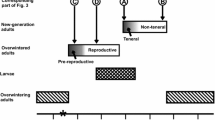Abstract
To analyse the change of mass in the resinous secretion of Roridula gorgonias, we carried out long-term measurements using a computerised ultra microbalance. In contrast to the aqueous mucilage of other carnivorous flypaper traps, this water-insoluble secretion does not desiccate even in dead and formalin-preserved plants. We found no significant desiccation of secretory drops within 10 h of continuous weighing. After 100 days of the secretion exposure to dry conditions, only about 8% of the mass was lost. Interestingly, returning these samples to humid conditions resulted in a mass recovery to the initial amount. This property of the secretion is discussed as an ecological adaptation to the periodically dry Fynbos habitat of the plant.




Similar content being viewed by others
References
Bruce AN (1907) On the distribution, structure, and function of the tentacles of Roridula. Notes R Bot Gard Edinb 17:83–98
Cowling RM, Richardson D, Patterson-Jones C (1995) Fynbos: South Africa’s Unique Floral Kingdom. Fernwood Press, 156 pp
Croteau R, Johnson MA (1984) Biosynthesis of terpenoids in glandular trichomes. In: Rodriguez E, Healey PL, Mehta I (eds) Biology and chemistry of plant trichomes. Plenum Press, New York, pp 133–186
Dell B (1977) Distribution and function of resins and glandular hairs in Western Australian plants. J R Soc West Aust 59:119–123
Dell B, McComb AJ (1978) Plant resins—their formation, secretion and possible functions. Adv Bot Res 6:277–316
Dolling WR, Palmer JM (1991) Pameridea (Hemiptera: Miridae): predaceous bugs specific to the highly viscid plant genus Roridula. Syst Ent 16:319–328
Ellis AG, Midgley JJ (1996) A new plant-animal mutualism involving a plant with sticky leaves and a resisdent hemipteran insect. Oecologia 106:478–481
Habenicht G (2002) Kleben: Grund, Technologien, Anwendung, 4th edn. Springer, Berlin, p 921
Hartmeyer S (1998) Carnivory in Byblis revisited II: the phenomenon of symbiosis on insect trapping plants. Carnivor Plant Newsl 27:110–113
Lloyd FE (1934) Is Roridula a carnivorous plant? Can J Res 10:780–786
Lloyd FE (1942) The carnivorous plants. The Ronald Press Company, New York, p 352
Manning J (2007) Field guide to Fynbos. New Holland Publishers, Australia, 507 pp
Marloth R (1903) Some recent observations on the biology of Roridula. Ann Bot 17:151–158
Marloth R (1910) Further observations on the biology of Roridula. Trans R Soc South Afr 2:59–62
Marloth R (1925) Flora of South Africa. Cambridge University Press, London, vol 2, Part I, pp 26–30
Schnepf E (1969) Sekretion und Exkretion bei Pflanzen. Protoplasmatologia, Handbuch der Protoplasmaforschung, Bd. 8, Physiologie des Protoplasmas. Springer, New York, p 181
Simoneit BRT, Medeiros PM, Wollenweber E (2008) Triterpenoids as major components of the insect-trapping glue of Roridula species. Z Naturforsch 63c:625–630
Voigt D, Gorb S (2008) An insect trap as habitat: cohesion-failure mechanism prevents adhesion of Pameridea roridulae bugs to the sticky surface of the plant Roridula gorgonias. J Exp Biol 211:2647–2657
Voigt D, Gorb S (2010) Locomotion in a sticky terrain. Arthropod Plant Interact 4:69–79
Voigt D, Gorb E, Gorb S (2009) Hierarchical organisation of the trap in the protocarnivorous plant Roridula gorgonias (Roridulaceae). J Exp Biol 212:3184–3191
Wollenweber E (2007) Flavonoids occuring in the sticky resin on Roridula dentata and Roridula gorgonias (Roridulaceae). Carniv Plant Newslett 36:77–80
Acknowledgments
Klaus Keller (Augsburg, Germany) kindly provided plants, bugs, and valuable discussions. Victoria Kastner (Max-Planck Institute of Metals Research, Stuttgart, Germany) helped with linguistic corrections of the manuscript. This study was partly supported by the Federal Ministry of Education and Research, Germany (BMBF, project InspiRat 01RI0633D) to SG.
Author information
Authors and Affiliations
Corresponding author
Rights and permissions
About this article
Cite this article
Voigt, D., Gorb, S. Desiccation resistance of adhesive secretion in the protocarnivorous plant Roridula gorgonias as an adaptation to periodically dry environment. Planta 232, 1511–1515 (2010). https://doi.org/10.1007/s00425-010-1270-2
Received:
Accepted:
Published:
Issue Date:
DOI: https://doi.org/10.1007/s00425-010-1270-2




